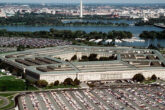April 13, 2017
How Trump Can Build a 350-Ship Navy
When President Donald Trump wanted to send a message to North Korea, he did it the old-fashioned way: by sending the USS Carl Vinson—a Nimitz-class aircraft carrier that holds a crew of 5,200 people and bristles with some 65 or so fixed-wing aircraft and helicopters—steaming toward the Korean Peninsula.
An aircraft carrier is the ultimate expression of American power, a floating military base whose arrival inspires fear in our enemies and heartens our allies. The Vinson, along with its strike group of two destroyers and one cruiser, certainly caused top officials in Beijing and Pyongyang to sit up and notice. North Korea called the deployment “outrageous,” while China expressed “concern.” If both countries’ leaders didn’t understand how serious Trump is about stopping North Korea’s race toward nuclear-tipped missiles, they get it now.
This is exactly why America has a Navy—and exactly why it’s so important that we rebuild it after years of atrophy as a result of the war on terrorism and budget constraints under President Barack Obama. Unfortunately, the Navy is no longer large enough to remain persistently forward-deployed to uphold international law or fully protect the nation’s interests. Set aside security threats like North Korea—the entire international economic system, nearly wholly dependent upon huge container ships, is nearing its fracture point. Once broken, this system based upon a loose maritime law consensus that is enforced by American naval might, will be difficult to reestablish.
Read the full article at Politico.
More from CNAS
-
The Department of Defense’s Breakthrough Nuclear Moment Risks Slipping Away
Unless they act, the Department of Defense’s breakthrough nuclear moment may vanish before it really happens....
By Will Rogers
-
DEFAERO Strategy Series [Apr 09, 25] CNAS' Becca Wasser and Phil Sheers on Revitalizing the U.S. Defense Industrial Base
On this episode of the Defense & Aerospace Report Strategy Series, sponsored by General Atomics Aeronautical Systems, Becca Wasser and Phil Sheers of the Center for a New Amer...
By Becca Wasser & Philip Sheers
-
From Production Lines to Front Lines
Executive Summary The U.S. defense industrial base (DIB) is struggling to meet the demands of the current strategic environment—let alone prepare for a potential conflict agai...
By Becca Wasser & Philip Sheers
-
The Pentagon’s Endangered Brain Trust
In this environment, sound assessments of emerging threats and new ideas to counter them will be especially vital....
By Dr. Andrew Krepinevich, Jr.




